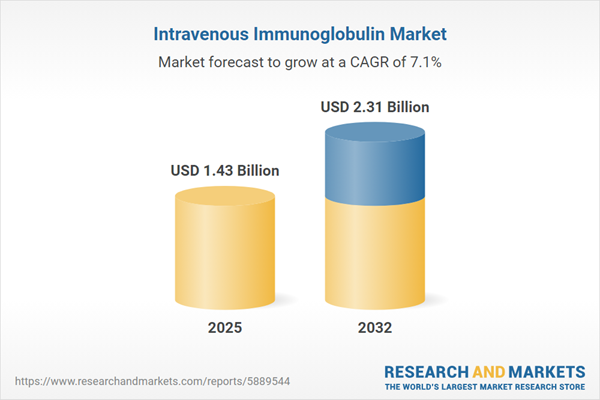Speak directly to the analyst to clarify any post sales queries you may have.
The intravenous immunoglobulin market is advancing as healthcare organizations seek greater agility, supply chain strength, and operational excellence. Senior decision-makers are closely evaluating market shifts to ensure robust positioning, effective service delivery, and ongoing compliance in a rapidly evolving sector.
Market Snapshot: Intravenous Immunoglobulin Market
With worldwide demand rising across varied treatment domains, the intravenous immunoglobulin market is sustaining strong growth and marked by frequent developments. Continuous innovation is enhancing therapies, broadening their clinical applications, and simplifying access for healthcare providers and patients. Distribution advancements facilitate timely delivery and address bottlenecks, while expanded manufacturing capacity empowers healthcare systems to serve a wider clinical spectrum, support compliance, and maintain steady supply flows. These factors, combined, drive operational effectiveness for organizations managing chronic treatments, simplify cross-border activity, and extend reach through diverse product portfolios and regional operations.
Scope & Segmentation
- End User: Home care organizations deliver ongoing management for chronic diseases. Hospitals are integral to acute and complex patient needs. Specialty clinics, particularly for hematology and immunology, help address rare and recurrent clinical conditions.
- Product Type: The sector provides high-purity intravenous immunoglobulin in both liquid formulations and lyophilized powder forms, supporting accurate dosing and diverse storage options suited to different care settings.
- Patient Type: Solutions are designed for pediatric, adult, and geriatric cohorts, allowing for individualized clinical approaches targeting disease-specific challenges across the patient population spectrum.
- Distribution Channel: Direct buying, hospital pharmacies, retail channels, and wholesalers each expand access, contributing to a resilient supply network for both institutional and home-based treatment environments.
- Indication: Main therapeutic focus areas include autoimmune disorders, neuromuscular conditions, hematological diseases, a range of immunodeficiency syndromes, and selected uses for complex diseases like Kawasaki disease and Guillain-Barré syndrome.
- Regions Covered: The market spans the Americas, Europe, Asia-Pacific, the Middle East, and Africa, with each region distinguished by unique regulatory climates and development stages that influence local supply and commercialization priorities.
- Key Companies Profiled: Key contributors shaping the market are CSL Limited, Grifols, Takeda Pharmaceutical Company Limited, Octapharma AG, Baxter International Inc., Biotest AG, Bio Products Laboratory Limited, Kedrion S.p.A., LFB S.A., and Shanghai RAAS Blood Products Co., Ltd.
Key Takeaways for Senior Decision-Makers
- Recent advances in plasma fractionation and infusion technology are offering increased transparency and more granular analytics, providing a stronger basis for strategic planning.
- Aligning operational protocols to fit new regulatory requirements supports streamlined compliance and prepares organizations for progressive reimbursement models at the regional and global level.
- Introduction of protein-based therapeutics and biosimilars delivers flexibility for care providers, enabling prompt adaptation to revisions in treatment guidelines.
- Strong logistics management is underpinning both facility- and home-based treatment delivery, increasing patient engagement and efficient resource allocation across varied geographies.
- Collaboration between public and private entities is leading to enhanced stability in plasma sourcing, sharpening risk controls, and ensuring dependable distribution networks for essential medicines.
- Variable pricing models and targeted compliance measures are key tools in sustaining organizational strength and enabling durable performance as market conditions evolve.
Tariff Impact on Supply Chains and Cost Structures
Revised tariffs for plasma-derived imports into the U.S. have prompted suppliers to rethink cost controls and diversify sourcing. Approaches include increasing domestic production, forming new supply partnerships, and monitoring tariffs to maintain price competitiveness and reliable supply. This industry shift underscores the importance of responsive procurement strategies and ongoing evaluation of supply chain cost structures for business continuity.
Methodology & Data Sources
The analysis utilizes thorough secondary research, parallel reviews of local and global regulatory frameworks, and detailed examination of academic studies. Insights are validated through executive interviews and expert practitioner review, ensuring depth and relevance for senior leadership.
Why This Report Matters
- Delivers practical intelligence for executive teams to adapt to regulatory changes and respond to evolving reimbursement needs with insights tailored by organizational context.
- Highlights clear segmentation and market benchmarks, underpinning improved risk management and supporting leaders in aligning strategies for ongoing industry transformation.
- Informs planning for continuous supply chain operations and readiness for potential shifts in compliance or sector standards.
Conclusion
This report offers senior leaders pragmatic guidance to navigate sector transformation, reinforce supply chain stability, and shape decisions that strengthen future-oriented organizational strategy in the intravenous immunoglobulin market.
Additional Product Information:
- Purchase of this report includes 1 year online access with quarterly updates.
- This report can be updated on request. Please contact our Customer Experience team using the Ask a Question widget on our website.
Table of Contents
3. Executive Summary
4. Market Overview
7. Cumulative Impact of Artificial Intelligence 2025
Companies Mentioned
The companies profiled in this Intravenous Immunoglobulin market report include:- CSL Limited
- Grifols, S.A.
- Takeda Pharmaceutical Company Limited
- Octapharma AG
- Baxter International Inc.
- Biotest AG
- Bio Products Laboratory Limited
- Kedrion S.p.A.
- LFB S.A.
- Shanghai RAAS Blood Products Co., Ltd.
Table Information
| Report Attribute | Details |
|---|---|
| No. of Pages | 194 |
| Published | November 2025 |
| Forecast Period | 2025 - 2032 |
| Estimated Market Value ( USD | $ 1.43 Billion |
| Forecasted Market Value ( USD | $ 2.31 Billion |
| Compound Annual Growth Rate | 7.1% |
| Regions Covered | Global |
| No. of Companies Mentioned | 11 |









